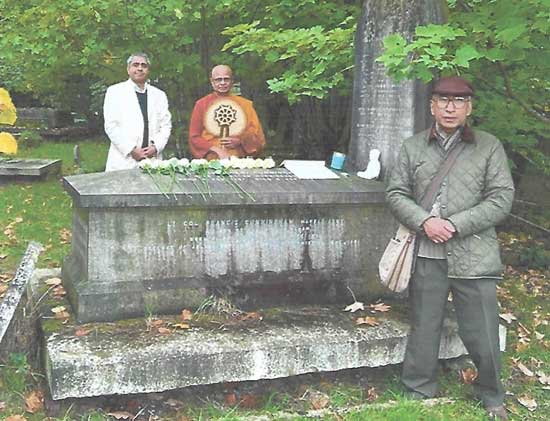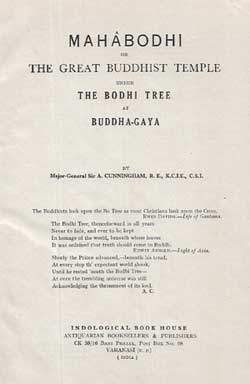Remembering Sir Alexander Cunningham, the Father of Indian Archaeology
A small ceremony took place at the Kensal Green cemetery in London on October 16 to honour the memory of Sir Alexander Cunningham, the eminent British archaeologist who played a pivotal role in the restoration of Buddhist sites in India in the 19th century.
Present at the ceremony were the Head Monk of the London Buddhist Vihara, Venerable Bogoda Seelawimala, Secretary Mahabodhi Society Amal Abeyawardene, V.G. Ratnasiri and the writer.
A summary of Sir Alexander Cunningham’s achievements in India was read out:

The ceremony at Kensal cemetery, London
Alexander Cunningham arrived in Calcutta to take up a post as a lieutenant in the Bengal Engineers. He became close friends with a very eminent Orientalist, James Prinsep, who identified the Emperor Ashoka. He and Prinsep submitted a paper to the Asiatic Society of Bengal on their numismatic studies in 1834.
His work involved surveying large areas of the Punjab and during these surveys he developed an abiding interest in identifying ancient sites. He acquired a knowledge of Sanskrit and was particularly interested in following the trails of the early Chinese pilgrims, Fa Xian and Hiuen Tsang. He excavated the Sarnath site in 1835-36 and opened the Dhamek Stupa.
In 1851 Cunningham and F.C. Maisey explored the Buddhist site at Sanchi. They investigated a number of stupas and afterwards published a book ‘The Bhilsa Topes’ which was the first detailed examination of the history of Indian Buddhism which included archaeological evidence.
Cunningham realised that these unofficial surveys were inadequate and wrote to the Viceroy, Lord Canning, in 1861 that: ‘It would rebound to the honour of the British government to institute a careful and systematic investigation of all existing monuments of ancient India’. The Viceroy agreed and Cunningham was appointed Archaeological Surveyor for the Government of India.
 A full government department, The Archaeological Survey of India was established in 1870 with Cunningham as its first Director-General.
A full government department, The Archaeological Survey of India was established in 1870 with Cunningham as its first Director-General.
Cunningham conducted excavations at Buddha Gaya in 1861 and provided a concise account of the site. He identified the Nalanda site in 1861.
It was during his visits to Kushinagara in 1861-62 that he identified the site as that of the Buddha’s parinibbana.
During his 1862-63 tour he identified the Sravasti site. In 1871 he published ‘The Ancient Geography of India’ which contained all his findings during several decades of investigations into India’s historical geography.
After retiring and returning to the UK in 1885 he published ‘Mahabodhi’ (1892) which was one of the earliest books on Buddha Gaya. While working on the Bharut Stupa in the early 1870s and at Sanchi he cooperated with the Sri Lankan Buddhist monk Waskaduwe Subhuti.
It is not surprising that he is known as the Father of Indian Archaeology.
The poem I quoted at the graveside by Cunningham about Buddha Gaya was:
Slowly the Prince advanced – beneath his tread
At every step th’expected world shook
Until he rested ‘neath the Bodhi Tree
At once the trembling universe was still
Acknowledging the thronement of its lord.
Flowers were laid on the grave. Ven. Seelawimala expressed their gratitude for the services rendered by Sir Alexander Cunningham which enabled Buddhist pilgrims to visit these holy sites after a period of 600 years and conducted the puja.
It was possibly the first time a group of Buddhists in London had formally honoured his memory.
Searching for an ideal partner? Find your soul mate on Hitad.lk, Sri Lanka's favourite marriage proposals page. With Hitad.lk matrimonial advertisements you have access to thousands of ads from potential suitors who are looking for someone just like you.


